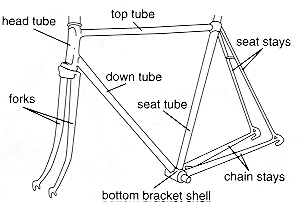| |
Structure
The
diagram shows the main structural components of a conventional
bicycle frame. Normally the material used is a steel, however aluminum alloys
are also used with this same geometry and at least one composite bike follows
a similar configuration. The frame geometry is almost two triangles but the
head tube makes the front section a quadrilateral. The joints in such a frame
are rigid and can, therefore, transmit torques as well as tensile and compressive
forces. Even with pin joints the triangular rear section would be
stable and its component tubes would be either in tension or compression and
experience no bending moments. With pinned joints the front section would be
unstable and the tubes could rotate through wide angles within the plane. For
this component the welded or brazed joints are required for stability.
In
normal use the materials are expected to stay in their elastic range so
that applied stresses must be below the yield stress of the material. Toughness
is also a desirable property so that the components will bend rather than
fracture if they are overloaded. |
|
|
|
|
|
|
|
|
|
|
|
|

